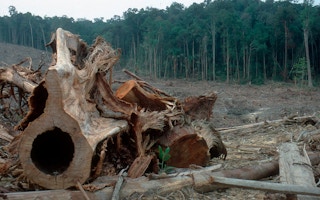The world’s great ecosystems − moderators of climate, nurseries for evolution − are still being destroyed in the service of global trade, to meet the rich world’s demands. Once again, researchers have confirmed that the wealthy nations are in effect ploughing savanna and felling tropical forests at a distance.
In the first 15 years of this century, the growing demand from the well-heeled for chocolate, rubber, cotton, soy, beef and exotic timber has meant that poorer nations have actually increased their levels of deforestation.
In effect, every human in the G7 nations − Canada, France, Germany, Italy, Japan, the UK and the US − is responsible for the loss of at least four trees a year, mostly in the developing world.
And in a separate study in another journal, another team of scientists has examined satellite data to confirm that between 1985 and 2018, humans cleared or altered 268 million hectares of natural ecosystem on the continent of South America. This is 2.68 million sq kilometres: an area almost the size of Argentina.
Two scientists in Japan report in Nature Ecology and Evolution that they matched levels of deforestation against trade with the world’s biggest economies, to find a clear correlation. They could even distinguish demand in one rich country and its impact on the forests of a poorer nation.
“While cocoa consumption in Germany poses the highest risk to the forests in Côte d’Ivoire and Ghana, deforestation in coastal Tanzania is dominated by Japanese consumers for some agricultural commodities, such as cotton and sesame seed,” they write.
“China shares the most significant responsibility for deforestation in Indochina − particularly in northern Laos for timber and rubber.”
Ironically, many of the richer nations have expanded the areas of forest on their own soil. More than 90 per cent of the deforestation caused by five of the G7 nations was beyond their own borders. In effect, the rich were exporting the destruction of the natural world, and the cost to the planet was disproportionate. The loss of three trees in the Amazon might be more damaging than the loss of 14 trees in Norway, the scientists argue.
“Most forests are in poorer countries who are overwhelmed with economic incentives to cut them down. Our findings show that richer countries are encouraging deforestation through demand for commodities,” said Keiichiro Kanemoto of the Research Institute for Humanity and Nature in Kyoto.
“Policies that aim to preserve forests need to also alleviate poverty. With the coronavirus pandemic, unemployment poses more challenges to forest conservation in developing countries. We want our data to assist in the policy making.”
South American losses
And in the journal Science Advances, a team from the University of Maryland reports on a closer look at the impact of demand for pulpwood, sugar cane, beef, corn and other commodities on one continent: South America, home to some of the world’s most important ecosystems.
They found that human impact on the continent’s land surface just between the years 1985 and 2018 had expanded by 60 per cent. In those years the natural tree cover had dwindled by 16 per cent, and the scale of pasture increased by 23 per cent, cropland by 160 per cent and plantation by 288 per cent.
The sum of all the altered land reached 268 million hectares, or 2.68m sq kms. Argentina, which coincidentally covers 2.73m sq kms, saw an increase of only 23 per cent in human conversion of land use. Brazil tipped the scales with an expansion of 65 per cent in those years.
And, say the researchers, of all this altered land cover on the continent, around 55 million hectares had been degraded − that is, it was no longer functioning as an ecosystem − while being employed for no commercial return. This is the equivalent of more than half a million square kilometres: an area slightly bigger than France.
“No region on Earth is likely to have experienced the scale of land conversion for the sake of agricultural commodity production that South America has,” the authors write.
This story was published with permission from Climate News Network.








